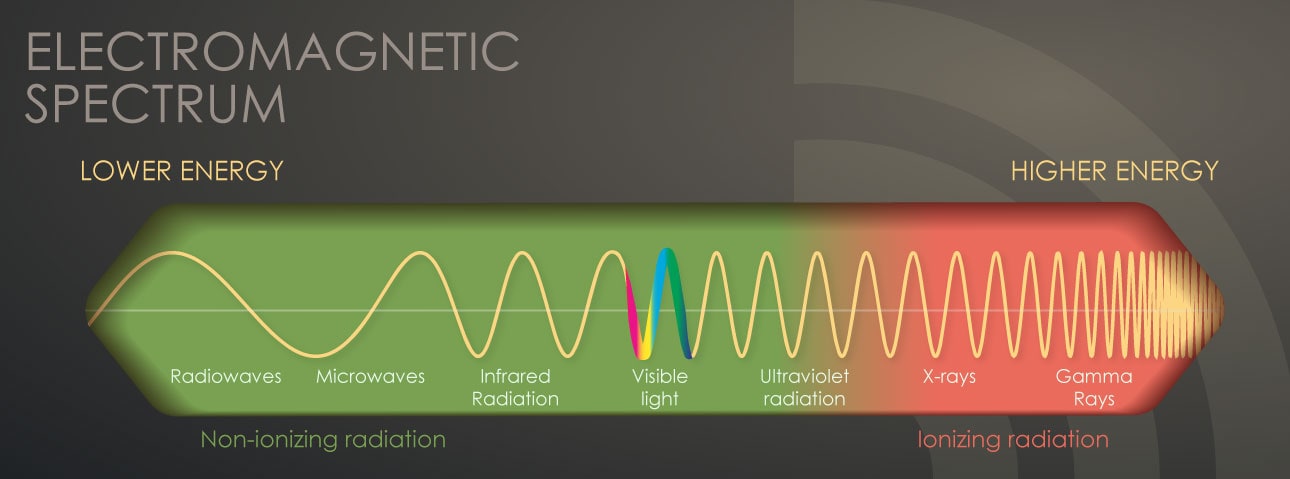Radiation Studies - CDC: Ionizing Radiation

The Electromagnetic Spectrum
Radiation exists all around us and is in two forms: ionizing and non-ionizing radiation.
Non-ionizing radiation is a form of radiation with less energy than ionizing radiation. Unlike ionizing radiation, non-ionizing radiation does not remove electrons from atoms or molecules of materials that include air, water, and living tissue.
What is ionizing radiation?
Ionizing radiation is a form of energy that acts by removing electrons from atoms and molecules of materials that include air, water, and living tissue. Ionizing radiation can travel unseen and pass through these materials. It is on the right side of the electromagnetic spectrum in the figure below.

A familiar example of ionizing radiation is that of x-rays, which can penetrate our body and reveal pictures of our bones. We say that x-rays are “ionizing,” meaning that they have the unique capability to remove electrons from atoms and molecules in the matter through which they pass. Ionizing activity can alter molecules within the cells of our body. That action may cause eventual harm (such as cancer). Intense exposures to ionizing radiation may produce skin or tissue damage.
Other examples of ionizing radiation include alpha, beta, and gamma rays from
radioactive decay.How much ionizing radiation am I exposed to?
We are exposed to low levels of ionizing radiation every day.
Ionizing radiation can fall into two categories: natural and manmade
Ionizing Radiation from Natural Sources
Ionizing radiation that comes from natural sources is typically at low levels. This means that the usual amount of ionizing radiation from natural sources absorbed by our bodies (dose) is small.
These low levels of exposure vary with location, altitude and type of building materials used in home construction. You may also be exposed to the radioactive gas radon if your house or building has a leaky foundation.
In nature, sources of ionizing radiation include:
Ionizing Radiation from Manmade Sources
Every day, we use Ionizing radiation to help us live healthy lives. Ionizing radiation is found in smoke detectors, used to disinfect medical instruments and blood, and to perform many other tasks in our daily lives. It is also a byproduct of nuclear power generation.
Our main exposure to ionizing radiation in manmade sources is through the use of diagnostic medical exams.
Medical exams that use ionizing radiation include:
What is the risk from exposure to ionizing radiation?
Ionizing radiation can penetrate the human body and the radiation energy can be absorbed in tissue. This has the potential to cause harmful effects to people, especially at high levels of exposure.
Natural Sources
Natural sources of ionizing radiation usually release ionizing radiation at low levels, which also means the amounts of radiation absorbed by our bodies (doses) is usually small. Natural sources of ionizing radiation include radioactive elements that are naturally in our body. For example, a very small fraction of the potassium in our bodies is radioactive.
Radon, however, is a natural radioactive gas found in rock formations that can release higher levels of radiation that can pose health risks. It is the second leading cause of lung cancer in the United States. The levels of radon in your home or building depend on a variety of factors. You can test your home or building to determine whether you or your family is at risk of high levels of radon exposure.
Manmade Sources
Medical diagnostic exams are the main manmade source of ionizing radiation exposure in the U.S. The goal of medical diagnostic imaging is for the benefits to far outweigh the risks.
You can track the number and type of these medical diagnostic exams that you receive on a regular basis so that you can know your history and share this with your medical provider.
Consult with your health care professional on matters of how an exam will help and whether another test that does not contain ionizing radiation may provide the same benefit. Magnetic Resonance Imaging (MRIs) and ultrasound technology are examples of diagnostic exams that do not involve exposure to ionizing radiation.
More information






















.png)












No hay comentarios:
Publicar un comentario